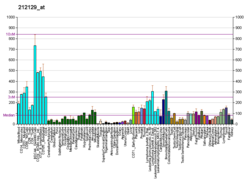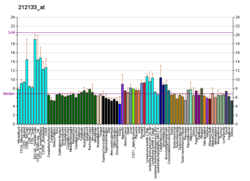| NIPA2 |
|---|
|
| Identifiers |
|---|
| Aliases | NIPA2, non imprinted in Prader-Willi/Angelman syndrome 2, SLC57A2, NIPA magnesium transporter 2 |
|---|
| External IDs | OMIM: 608146; MGI: 1913918; HomoloGene: 11368; GeneCards: NIPA2; OMA:NIPA2 - orthologs |
|---|
| Gene location (Human) |
|---|
 | | Chr. | Chromosome 15 (human)[1] |
|---|
| | Band | 15q11.2 | Start | 22,838,644 bp[1] |
|---|
| End | 22,869,362 bp[1] |
|---|
|
| Gene location (Mouse) |
|---|
 | | Chr. | Chromosome 7 (mouse)[2] |
|---|
| | Band | 7|7 B5 | Start | 55,581,035 bp[2] |
|---|
| End | 55,612,224 bp[2] |
|---|
|
| RNA expression pattern |
|---|
| Bgee | | Human | Mouse (ortholog) |
|---|
| Top expressed in | - pancreatic ductal cell
- mucosa of colon
- mucosa of sigmoid colon
- secondary oocyte
- mucosa of ileum
- nasal epithelium
- rectum
- right ventricle
- islet of Langerhans
- duodenum
|
| | Top expressed in | - epithelium of small intestine
- submandibular gland
- gastrula
- ileum
- left colon
- transitional epithelium of urinary bladder
- interventricular septum
- atrioventricular valve
- jejunum
- epithelium of stomach
|
| | More reference expression data |
|
|---|
| BioGPS | 
 | | More reference expression data |
|
|---|
|
| Gene ontology |
|---|
| Molecular function | - magnesium ion transmembrane transporter activity
| | Cellular component | - integral component of membrane
- endosome
- plasma membrane
- early endosome
- membrane
| | Biological process | - magnesium ion transmembrane transport
- ion transport
- magnesium ion transport
| | Sources:Amigo / QuickGO |
|
| Orthologs |
|---|
| Species | Human | Mouse |
|---|
| Entrez | | |
|---|
| Ensembl | | |
|---|
| UniProt | | |
|---|
| RefSeq (mRNA) | NM_001008860
NM_001008892
NM_001008894
NM_001184888
NM_001184889
|
|---|
NM_030922 |
| |
|---|
NM_001256130
NM_001256131
NM_001256132
NM_001256133
NM_023647 |
|
|---|
| RefSeq (protein) | NP_001008860
NP_001008892
NP_001008894
NP_001171817
NP_001171818
|
|---|
NP_112184 |
| |
|---|
NP_001243059
NP_001243060
NP_001243061
NP_001243062
NP_076136 |
|
|---|
| Location (UCSC) | Chr 15: 22.84 – 22.87 Mb | Chr 7: 55.58 – 55.61 Mb |
|---|
| PubMed search | [3] | [4] |
|---|
|
| Wikidata |
| View/Edit Human | View/Edit Mouse |
|



















